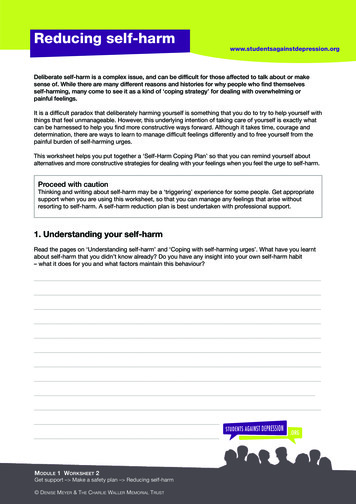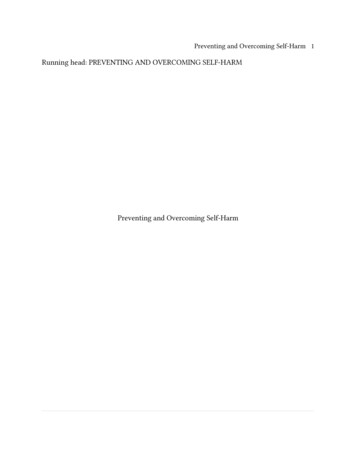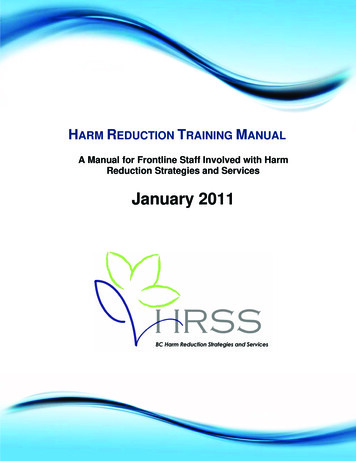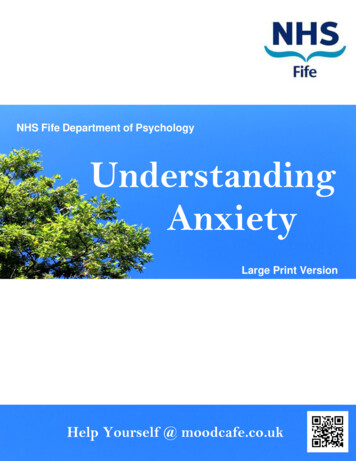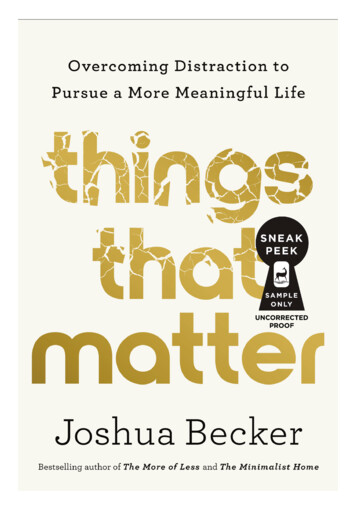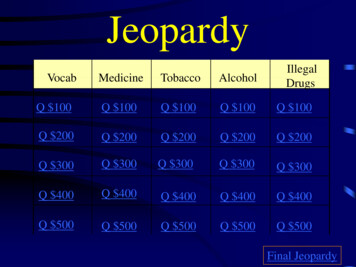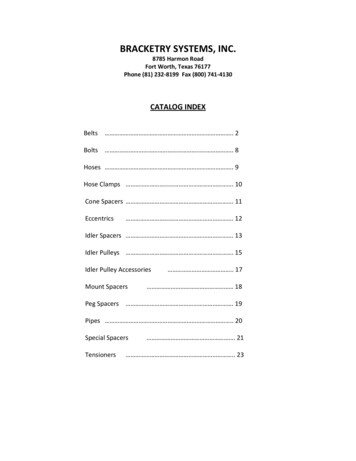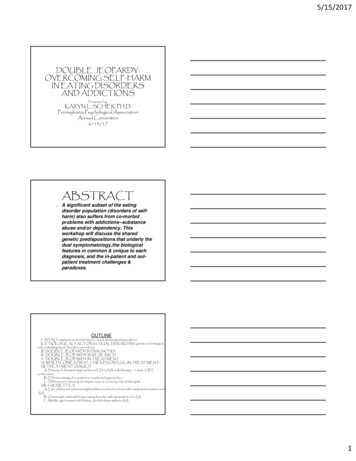
Transcription
5/15/2017DOUBLE JEOPARDY:OVERCOMING SELF-HARMIN EATING DISORDERSAND ADDICTIONSPresented by:KARYN L. SCHER, PH.D.Pennsylvania Psychological AssociationAnnual Convention6/14/17ABSTRACTA significant subset of the eatingdisorder population (disorders of selfharm) also suffers from co-morbidproblems with addictions--substanceabuse and/or dependency. Thisworkshop will discuss the sharedgenetic predispositions that underly thedual symptomatology,the biologicalfeatures in common & unique to eachdiagnosis, and the in-patient and outpatient treatment challenges ¶doxes.OUTLINEI. INTRO: emphasis on alcohol abuse; caveat about opioid prevalenceII. ETIOLOGICAL FACTORS & DUAL DIAGNOSIS: genetics & biologicalrisk; underlying mood disorders; prevalenceIII. DOUBLE JEOPARDY IN DIAGNOSISIV. DOUBLE JEOPARDY IN RESEARCHV. DOUBLE JEOPARDY IN TREATMENTVI. WHICH COMES FIRST, CHICKEN OR EGG, IN TREATMENT?VII. TREATMENT ISSUESA. History of divergent approaches to ED vs SA--talk therapy, 12-step, CBT,combinationB. Effective timing of in-patient or residential approachesC. Differences in meaning of relapse/cure or recovery/role of therapistVIII. 3 VIGNETTESA. Late adolescent with low weight bulimia and alcohol abuse with residential treatment andAA.B. Overweight adult with binge eating disorder with out-patient and AAC. Middle-aged woman with bulimia, alcohol abuse without AA.1
5/15/2017I. IntroductionUntil 2014, lack of evidenced-based researchon co-morbid populations and treatmentMore questions than answers: are geneticsshared? are eating disorders addictions? howdoes trauma/PTSD trigger? how are theysimilar/different?Focus today will NOT lic steroid use. Caveat aboutthe opioid crisisII. ETIOLOGICAL FACTORS & DUALDIAGNOSIS:genetics & biological risk; underlying mood disorders; prevalenceA. Both aggregate in families.B. Increased risk with one diagnosis: 50% of ED pts.meet criteria for SUD; 1/3 of SUD report eatingpathology; having SUD risk of psychiatric disorder(see Table of Risk-next slide)C. Dopamine implicated in both: similar neural systemsfor appetite control and drug use. 45% of obese subjectshad DRD2 gene, as did alcoholicsD. Chromosome studies:E. Similarities/differences in neurobiology fromneuroimagingF. Appetite peptides and suppressing hormones alsoseem to regulate addictive behaviors.2
5/15/2017Co-Morbidity Risk:Large, Population-Based EpidemiologicalSurveysfrom Brownell & Gold, Food & Addiction (2012)29.7% of respondents w/ LIFETIME SUD have LIFETIME MOODDISORDER32-41.2% respondents w/ LIFETIME MOOD DISORDER. haveLIFETIME SUD40.7% of respondents w/ LIFETIME SUD have LIFETIME ANXIETYDIS.23.7-37.8%respondents w/LIFETIME ANXIETY DIS. have LIFETIMESUD45.2% of respondents w/ LIFETIME PTSD have LIFETIME SUD27% of respondents w/ LIFETIME ANOREXIA have LIFETIME SUD36.8% respondents w/ LIFETIME BULIMIA have LIFETIME SUD23.3% respondents w/ LIFETIME BINGE ED have LIFETIME SUDIII. DOUBLE JEOPARDY INDIAGNOSISA. Psychiatric conditions that predispose development of malnutrition include thesubstance use disorders (as well as ED, mood disorders, schizophrenia, ADHD).B. Prevalence of young women using substances to control their caloric intake, settingup medical crises.C. Medical complications: (see Table)1. vitamin deficiencies2. electrolyte imbalances3. increased risk of death4. abuse of weight control substances in eating disorders5. increased problems with alcohol post bariatric surgeryD. ADDICTION as a diagnostic term, only first appeared in a diagnostic manual withthe 2013 publication of DSM-5.E. LOSS OF CONTROL feature in ED and SUD.NUTRITIONAL PROBLEMS & RELATED SYMPTOMS INSUD & EDNOTE: no studies yet specifically assessing increased risk of malnutrition with ED/SUD co-occurringfrom Brewerton & Dennis (2014)PROBLEMSYMPTOMAnorexiaAlcohol UseLiver problemsDisordermuscle wasting, thinninghair, edema, anemiaGlucoseAnorexiaAlcohol UseDisorderHyperglycemia/comashakiness, tachycardia,cold sensitivitySodiumAnorexiaAlcohol UseDisorderCentral NervousSystem problemsnausea, irritability, fatigue,headaches, faintingCardiacProblemsweakness, tachycardia,HBP, hi LDLArrhythmiasbruising, low bone density,fracturesSkin problems,anemiamouth ulcers, tassiumSUDAnorexia/Buli Alcohol UsemiaDisorderCalcium (& Anorexia/Buli Alcohol ohol UseDisorder3
5/15/2017A. Restriction of energy intake relative to requirements, leading to a significantly low bodyweight in the context of age, sex, developmental trajectory, and physical health.Significantly low weight is defined as a weight that is less than minimally normal, or forchildren and adolescents, less than that minimally expected.B. Intense fear of gaining weight or of becoming fat, or persistent behavior that interfereswith weight gain, even though at a significantly low weight.C. Disturbance in the way in which one's body weight or shape is experienced, undueinfluence of body weight or shape on self-evaluation, or persistent lack of recognition ofthe seriousness of the current low body weight.Specify whether:Restricting type: During the last three months, the individual has not engaged in recurrentepisodes of binge eating or purging behavior (i.e., self-induced vomiting or the misuse oflaxatives, diuretics, or enemas.) This subtype describes presentations in which weight lossis accomplished primarily through dieting, fasting, and/or excessive exercise.Binge-eating/purging type: During the last three months, the individual has engaged inrecurrent episodes of binge eating or purging behavior (i.e., self-induced vomiting or theifltiditifA. Recurrent episodes of binge eating. An episode of binge eating is characterized by both of the following:1. 1) Eating, in a discrete period of time (e.g., within any two-hour period), an amount of food that is definitelylarger than most people would eat during a similar period of time and under similar circumstances.2. 2) A sense of lack of control over eating during the episode (e.g., a feeling that one cannot stop eating orcontrol what or how much one is eating).B. Recurrent inappropriate compensatory behavior to prevent weight gain, such as self- induced vomiting;misuse of laxatives, diuretics, enemas, or other medications; fasting; or ex-cessive exercise.C. The binge eating and inappropriate compensatory behaviors both occur, on average, at least once a week forthree months.D. Self-evaluation is unduly influenced by body shape and weight.E. The disturbance does not occur exclusively during episodes of anorexia nervosa.Specify current severity: The minimum level of severity is based on the frequency of inappropriate compensatorybehaviors (see below). The level of severity may be increased to reflect other symptoms and the degree offunctional disability.Mild: An average of 1 to 3 episodes per week. Moderate: An average of 4 to 7 episodes per week. Severe: Anaverage of 8 to 13 episodes per week. Extreme: An average of 14 or more episodes per week.DSM-5 Criteria for Binge Eating Disorder Recurrent episodes of binge eating. An episode of binge eating is characterized byboth of the following: eating, in a discrete period of time (for example, within any 2-hour period), anamount of food that is definitely larger than most people would eat in a similarperiod of time under similar circumstances a sense of lack of control over eating during the episode (for example, a feelingthat one cannot stop eating or control what or how much one is eating) The binge-eating episodes are associated with three (or more) of the following: eating much more rapidly than normal eating until feeling uncomfortably full eating large amounts of food when not feeling physically hungry eating alone because of feeling embarrassed by how much one is eating feeling disgusted with oneself, depressed, or very guilty afterwards Marked distress regarding binge eating is present. The binge eating occurs, on average, at least once a week for three months. The binge eating is not associated with the recurrent use of inappropriatecompensatory behavior (for example, purging) and does not occur exclusively duringthe course Anorexia Nervosa, Bulimia Nervosa, or Avoidant/Restrictive Food IntakeDisorder.4
5/15/2017DSM-5 Criteria for Substance Use DisorderA problematic pattern of substance use leading to clinically significant impairment or distress as manifested by at least two of thefollowing occurring in a 12-month period:1. substance is often taken in larger amounts or over alonger period of time than was intended2. persistent desire or unsuccessful efforts to cut down or control substance use3. great deal of time is spent in activities necessary to obtain the substance, use the substance, or recover from its effects4. craving or strong desire to use the substance5. recurrent use resulting in failure to fulfill majorrole obligations at work, school, home6. continued substance use despite having persistent or recurrent social or interpersonal problems7. important social, occupational, or recreational activities are given up or reduced because of substance use8. recurrent substance use in situations in which it isphysically hazardous9. substance use is continued despite knowledge of having a persistent or recurrent physical or psychological problem that islikely to have been caused or exacerbated by the substance10. tolerance, as defined by either of the following:a. a need for markedly increased amounts of the substance to achieve intoxication or desired effectb. a markedly diminished effect with continued use of the same amount of substance11. withdrawal, as manifested by either of the following:a. characteristic withdrawal syndrome for the substanceb. use of the substance or closely related substance is taken to relieve or avoid withdrawal symptomsSeverity Specifiers: Mild: 2-3 symptoms Moderate: 4-5 symptoms Severe: 6 or more symptomsCourse Specifiers: early remission sustained remission in a controlled environment on maintenance therapy(NOTE: 1-10 CAN APPLY TO FOOD-AS-SUBSTANCE; 11 APPLIES IN ANIMALSTUDIES)IV. DOUBLE JEOPARDY INRESEARCHA. “Research on how best to treat co-occurring eating disorders and substance usedisorders is almost entirely lacking.”B. Problems conducting research on dual diagnosis/treatment:1. No uniform definition of “food addiction,”therefore likelihood of misclassification.2. Screening tools for dual are not validated; self-report not consistent.3. Eating Disorders AND Substance Use Disorders are comprised ofheterogeneous subgroups.4. Validation of the Yale Food Addiction Scale (YFAS) ongoing, but based upon theDSM-IV.C. Reliance on animal models--studies on rats bred with tendencies to prefer alcohol,drink saccharin, etc, and observing their responses to sweets/naltrexone may notgeneralize.V. DOUBLE JEOPARDY INTREATMENTA. “To date, there are no evidence-based treatments toguide the practitioner faced with this co-morbid condition”B. 3 models for dealing with both:1. SEQUENTIAL2. PARALLEL3. INTEGRATEDC. Few empirical studies; only ones are for #3.D. Historically, in SUD programs, only 1/2 assessed forED, and typically did not treat.E. BIGGEST PROBLEM IS THATTREATMENT MODELS FOR BOTH AREUNIMPRESSIVE FOR FULL RECOVERY.5
5/15/2017VI. WHICH COMES FIRST,CHICKEN OR EGG, INTREATMENT?A. Assess and screen for medical issues, dual diagnosis,need for detox.B. Pharmacological treatment of psychiatric conditions(implications for relapsing substance users).C. Medical complications may mandate(esp in ED)D. Detox may mandate(esp in SUD), and approved medsE. Expertise in the facility--3 blind men and the elephantF. Grilo’s suggestion: “In the absence of EBT, use CBT,DBT, etc., as starting point.,” but WHAT ABOUTAA?VII. TREATMENTISSUESA. Divergent Approaches in Treatment1. CBT, MOTIVATIONAL ENHANCEMENT, 12-STEPFACILITATION2. COMPLETE ABSTINENCE works for SUD; MODERATION betterfor ED.B. In-patient vs. Out-patient1. American Psychiatric Association Hospitalization Criteria: medical instability with impairment psychological and social abnormalities lack of response to reasonable trial of out-patient treatment suicidality need for 24 hour, structured, multi-disciplinary care lack of family support or emotional toxicity2. Dilemma between balancing patient’s autonomy with preventing life-threatening outcome(comment on civil commitment issue)3. Cost concerns and insurance dictates6
5/15/2017VII. TREATMENTISSUES(continued)C. Meaning of relapse/recovery/role oftherapist1. Relapse SUD: HALT, Lapse/Relapse/Collapse, Serenity Prayer are keyRelapse ED: Expected, opportunity for growth, problem solving, identifyingemotional triggers.2. Recovery SUD: Even with complete sobriety, always ‘recover-ing.’Recovery ED: 1/3, 1/3, 1/3--approximate percentages who make full versuspartial recovery versus remaining chronically eating disordered. BOTH HAVE VARIABLE COURSES OF RECOVERY Betty Ford Center definition: “voluntarily maintained life style composed andcharacterized by sobriety, personal health, and citizenship.”3. Therapist Role in Both: motivate and address obstacles to recovery.UNIQUE MANUALIZEDRECOVERY PROGRAMTARGETINGDUAL DIAGNOSIS OFED/SUDFeatures of S.F. Greenfield’s Treating Women withSubstance Use Disorders: The Women’s RecoveryGroup ManualA. Fourth session entirely devoted to: Managing Mood, Anxiety, & Eating Problemswithout Using Substance.B. Offers some explanations for the relationship between SUD and anxiety,depression, eating disorders.C. Specific coping strategies for addressing ALL 3 ILLNESSES, e.g.:1. Understand/accept that the substance disorder and the other disorder or disorders are BOTH/ALL IMPORTANT and requireattention/treatment.2. Don’t use substances to manage the other disorders AND don’t let the other disorders stop you from your recovery from substance problem.3. Cravings and negative thinking in both are explained. SELF-CARE TECHNIQUES TO COPE WITH BOTH AREENCOURAGED.7
5/15/2017VIII. DISCUSSIONQUESTIONSFOR VIGNETTESA. What is the role of biological factors in diagnosis?B. Would you consider any aspect of this an addiction?C. What should the priority be in treatment?D. Is there a disorder that seems primary?E. What are the pros/cons of treating one or the otherfirst?F. What are the pros/cons of a more structured treatmentenvironment?VIII. VIGNETTE #1Late adolescent with low weight bulimia and alcohol abuse with residentialtreatment and AA. Robin was a 19 year old second semester college freshman when she presentedfor treatment after a 6 week stay at an eating disorder inpatient facility. Sheembraced various aspects of the program (family meetings, nutrition counseling) andreported that she identified with other young women in the community, and felt lesssocially anxious in that environment. She acknowledged that, when away at school,she often binge-drank, but that her patterns were similar to her roommates. She wasdetermined to return to school in the fall and resume her studies and social activities.This phase of therapy primarily focused on the ED. Her return to school was marked by regression with the ED, exacerbation of herdrinking, and lead to a DUI. She wanted to return to ED residential treatment, butthere were concerns that the alcohol problem was not being addressed. It isnoteworthy that both parents were adult children of alcoholic fathers, and there areaunts and cousins with drinking problems. Seeking treatment was a conundrum because the ED program wanted her to treatthe SUD first, and a world class SUD program recommended she treat the ED first. Eventually, she found an IOP that offered focus on both at the same time, with afirm requirement to attend AA meetings.VIII. VIGNETTE #2Overweight adult with binge eating disorder with out-patient and AA Sharon was 26 when she returned to psychotherapy years after an adolescent boutwith anorexia and bulimia, for which she was treated and stabilized, albeit at a highweight for her height. She was managed on anti-depressant medication (there hadbeen a suicide attempt before college). Her mother was a functional alcoholic(successful in her career) and through the earlier phase of treatment made it clearthat she was not going to stop drinking. Sharon admitted that she frequently drove drunk and knew this was a seriousproblem. In addition, she admitted that she had become a binge eater, and at timesacted out sexually with men she met online. She needed to retain her nanny job tocover insurance expenses and ready herself for moving out of her parents’ home,which she felt exacerbated her problems. She had insight and motivation, but not anetwork of support. Therapy focused on letting go of attempts to persuade her to return to an in-patientprogram, and instead to work with her motivation to stop drinking on an out-patientbasis. The first hurdle was overcome when she found a suitable AA meeting and asponsor, who was less than 10 years older than she. Sharon took to AA like a duckto water, and often shared her story. Therapy attempted to combine a focus on thebinge eating problem, but Sharon was deeply resistant to this.8
5/15/2017VIII. VIGNETTE #3Middle-aged woman with bulimia, alcohol abuse without AA Betsy had been in therapy in her mid-thirties after she developed bulimia at anatypical developmental stage. She appeared to use therapy well to reduce her bingingand purging, although it was never completely eliminated. She reported having othertherapists who believed her problems would be solved if she got into an intimaterelationship, but in this phase of therapy, her living alone was accepted as her chosenlife style. Her father and brother both appeared to have serious anger managementproblems, with the brother also experiencing bouts of depression. She was quite resistant to any recommendations to have a physical with blood work,usually an early treatment requirement, and showed up one day with a notarizedstatement absolving the therapist of any liability because she was choosing not tofollow this treatment recommendation. Fast forward about 15 years and Betsy returned with an astonishing confession: shehad been a daily binge drinker and had stopped cold turkey about 4 years beforereturning to therapy when her bulimia resumed and she had a series of severe anxietyattacks. She was proud of having achieved an alcohol free life style without additionaltherapeutic or 12-step support, but recognized that she still was “numbing out” withfood, and that was still not managing her anxiety. She attended an ED/weightmanagement group, got short-term medication for her anxiety, and began usingtherapy in a more honest, revealing way.SELECTED BIBLIOGRAPHY American Psychiatric Association. (2013) Diagnostic and Statistical Manual ofMental Disorders(5th Edition). Washington, D.C.: American PsychiatricAssociation. Brewerton, T.D. & Dennis, A.B. (ed.) (2014) Eating Disorders, Addictions, &Substance Abuse Disorders. London: Springer. Brownell, K.D. & Gold, M.S. (ed.) (2012) Food and Addiction: A ComprehensiveHandbook. New York: Oxford. Carr, K.D. (2002) Augmentation of drug reward by chronic food restriction:Behavioral evidence and underlying mechanisms. Physiological Behavior. 76(3):353-364. Gearhardt, A.N., Corbin, W.R., Brownell, K.D. (2009) Preliminary Validation of theYale Food Addiction Scale. Appetite. 52:32-36. Greenfiled, S.I. (2016) Treating Women with Substance Use Disorders. New York:Guilford Grilo, C.M. Sinha, R., O’Malley, S.S. (2002) Eating Disorders and Alcohol UseDisorders. Alcohol Research Health. 26(2):151-160. Petrucelli, J. & Stuart, C. (ed.) (2001) Hunger and Compulsions: ThePsychodynamic Treatment of Eating Disorders and Addictions. New Jersey: Norton. Schenker, M.D. (2009) A Clinician’s Guide to 12-Step Recovery: Integrating 12StepPrograms into Psychotherapy. New York: Norton.9
1. substance is often taken in larger amounts or over a longer period of time than was intended 2. persistent desire or unsuccessful efforts to cut down or control substance use 3. great deal of time is spent in activities necessary to obtain the substance, use the substance, or recover from its effects 4. craving or strong desire to use the .

